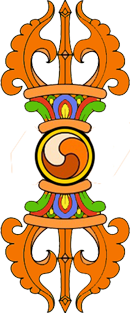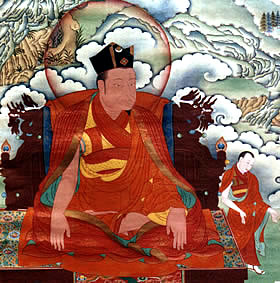


Karma Pakshi, the Second Karmapa
 “Mastering the yidam, you gained control over the world of appearance. You tamed the haughtiness of the tirthika emperor of Mongolia, And conquered the energy of fire, water, poison, weaponry and demons. Karma Pakshi, we supplicate at your feet.”
“Mastering the yidam, you gained control over the world of appearance. You tamed the haughtiness of the tirthika emperor of Mongolia, And conquered the energy of fire, water, poison, weaponry and demons. Karma Pakshi, we supplicate at your feet.”
—from Supplication To The Karmapas
Karma Pakshi’s birth and childhood
Born in Kyil-le Tsakto in eastern Tibet to a noble family of yogins, the young boy was named Chözin by Khache Panchen. He was a child prodigy who already had a broad understanding of Buddhist philosophy and practice before the age of ten.
Recognition as the rebirth of Karmapa
On his way to Central Tibet for further education, he encountered Pomdrakpa, who had received the full Kagyu transmission from Drogön Rechen, the first Karmapa’s spiritual heir. Pomdrakpa realized, through certain very clear visions, that the child he met was the reincarnation of Düsum Khyenpa. Pomdrakpa conferred on the young Karma Pakshi all the teachings through traditional empowerments and formally passed on the lineage in full. Ever since this time, each young Karmapa, despite his pre-existing knowledge and accomplishment of the teachings, formally receives all the transmissions of the teachings from a lineage holder.
The second Karmapa spent much of the first half of his life in meditation retreat. He also visited and restored the monasteries established by the first Karmapa. He is famous for having introduced the melodious chanting of the Om Mani Padme Hung, the mantra of compassion, to the Tibetan people.
Karma Pakshi and Kublai Khan
At the age of 47 (1252), he set out on a three-year journey, at the invitation of Kublai, grandson of Ghengis Khan. Chinese and Tibetan histories, record that the Karmapa was said to have performed many spectacular miracles at the court. He also played an important role as a peacemaker. However, the Karmapa declined to stay permanently in the court, which caused Kublai Khan’s displeasure.
Over the next ten years the Karmapa traveled widely in China, Mongolia and Tibet and became a teacher of the greatest renown. He was particularly honored by Möngke Khan, Kublai’s brother, the Mongol ruler at that time. The Karmapa was presented the Great Golden Seal of “Di shri.”
After Möngke’s death, Kublai became the Khan and ruled a vast empire. However, harboring resentment against the Karmapa for his refusal to stay in the court of Kublai and due to his perception that the Karmapa had paid more attention to the Munga Kahn many years before, Kublai Kahn ordered the apprehension of the Second Karmapa. The Karmapa thwarted each attempt to capture, or even kill him, despite the overwhelming forces sent against him. As the Karmapa continually responded to force with compassion, Kublai Khan eventually had a change of heart. As time passed, gradually Kublai Khan came to regret his actions against the Karmapa, and eventually approached him, confessing his misdeeds, and requesting Karma Pakshi to teach him.
Karma Pakshi’s miracles of meditation and scholarship
In fulfillment of a long-standing vision, His Holiness returned to Tibet and directed the building of a Buddha statue at Tsurphu, well over fifty feet in height. The finished statue was slightly tilted. In one of the most well-known miraculous stories of the Karmapas, Karma Pakshi was said to have straightened the statue by assuming the same tilted posture as the statue, and straightening himself. The statue simultaneously righted itself.
The histories record that the Second Karmapa composed over one hundred volumes of texts, which once were enshrined at the monastic library of Tshurphu monastery in Central Tibet.
Before passing away into parinirvana, Karma Pakshi told details concerning the next Karmapa’s birth to his main disciple, Orgyenpa.
A play on the life story of Karma Pakshi
In 2012 the 17th Karmapa composed and directed a three-part play about the life of Karma Pakshi. You can watch the recording on YouTube.




